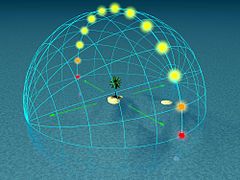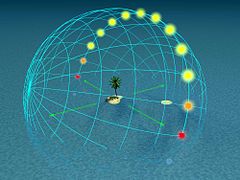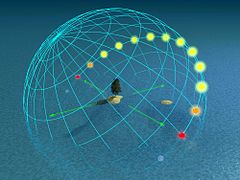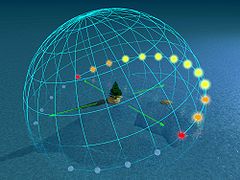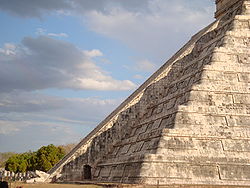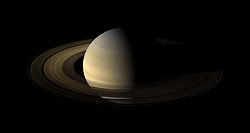- Equinox
-
This article is about the astronomical event when the sun is at zenith over the Equator. For other uses, see Equinox (disambiguation).For the same event happening on other planets and setting up a celestial coordinate system, see Equinox (celestial coordinates).
UTC date and time of solstices and equinoxes[1] year Equinox
MarSolstice
JuneEquinox
SeptSolstice
Decday time day time day time day time 2004 20 06:49 21 00:57 22 16:30 21 12:42 2005 20 12:33 21 06:46 22 22:23 21 18:35 2006 20 18:26 21 12:26 23 04:03 22 00:22 2007 21 00:07 21 18:06 23 09:51 22 06:08 2008 20 05:48 20 23:59 22 15:44 21 12:04 2009 20 11:44 21 05:45 22 21:18 21 17:47 2010 20 17:32 21 11:28 23 03:09 21 23:38 2011 20 23:21 21 17:16 23 09:04 22 05:30 2012 20 05:14 20 23:09 22 14:49 21 11:11 2013 20 11:02 21 05:04 22 20:44 21 17:11 2014 20 16:57 21 10:51 23 02:29 21 23:03 2015 20 22:45 21 16:38 23 08:20 22 04:48 2016 20 04:30 20 22:34 22 14:21 21 10:44 2017 20 10:28 21 04:24 22 20:02 21 16:28 An equinox occurs twice a year, when the tilt of the Earth's axis is inclined neither away from nor towards the Sun, the center of the Sun being in the same plane as the Earth's equator. The term equinox can also be used in a broader sense, meaning the date when such a passage happens. The name "equinox" is derived from the Latin aequus (equal) and nox (night), because around the equinox, the night and day have approximately equal length.
At an equinox, the Sun is at one of two opposite points on the celestial sphere where the celestial equator (i.e. declination 0) and ecliptic intersect. These points of intersection are called equinoctial points: classically, the vernal point and the autumnal point. By extension, the term equinox may denote an equinoctial point.
An equinox happens each year at two specific moments in time (rather than two whole days), when there is a location (the subsolar point) on the Earth's equator, where the center of the Sun can be observed to be vertically overhead, occurring around March 20/21 and September 22/23 each year.
Although the word equinox is often understood to mean "equal [day and] night," this is not strictly true. For most locations on earth, there are two distinct identifiable days per year when the length of day and night are closest to being equal; those days are referred to as the "equiluxes" to distinguish them from the equinoxes. Equinoxes are points in time, but equiluxes are days. By convention, equiluxes are the days where sunrise and sunset are closest to being exactly 12 hours apart.[2][3]
-
Animation made from satellite images showing the changing light patterns on the Earth through a year.
Date
When Julius Caesar established his calendar in 45 BC, he fixed the Spring equinox on March 25. The reasons of the actual shift to March 21 are linked to the goal followed by Pope Gregory XIII to create his modern Gregorian calendar. In fact, the Pope was not moved by the desire to honor the Roman emperor, but to restore the edicts about the date of Easter of the Council of Nicaea of AD 325. Incidentally, the date of Easter itself is fixed by an approximation of lunar cycles used in the Hebraic calendar, but according to the historian Bede the name comes from a pagan celebration by the Germanic tribes of the vernal (spring) equinox. So, the shift in the date of the equinox that occurred between the 4th and the 16th centuries was annulled with the Gregorian calendar, but nothing was done for the first four centuries of the Julian calendar. The days of February 29 of the years AD 100, AD 200, AD 300, and the day created by the irregular application of leap years between the assassination of Caesar and the decree of Augustus re-arranging the calendar in AD 8, remained in effect, and moved the equinox four days earlier than in Caesar's time.
Names
- Vernal equinox and autumnal equinox: these classical names are direct derivatives of Latin (ver = spring and autumnus = autumn).
- March equinox and September equinox: a usage becoming the preferred standard by technical writers choosing to avoid Northern Hemisphere bias (implied by assuming that March is in the springtime and September is autumnal—true for those in the Northern Hemisphere but exactly opposite in the Southern Hemisphere).
- Northward equinox and southward equinox: names referring to the apparent motion of the Sun at the times of the equinox.
- Vernal point and autumnal point are the points on the celestial sphere where the Sun is located on the vernal equinox and autumnal equinox respectively (again, the seasonal attribution is that of the Northern Hemisphere).
- First point (or cusp) of Aries and first point of Libra are names used by navigators and astrologers. Navigational ephemeris tables record the geographic position of the First Point of Aries as the reference for position of navigational stars. Due to the precession of the equinoxes, the astrological signs of the tropical zodiac where these equinoxes are located no longer correspond with the actual constellations once ascribed to them. The equinoxes are currently in the constellations of Pisces and Virgo. In sidereal astrology (notably Hindu astrology), by contrast, the first point of Aries remains aligned with Ras Hammel "the head of the ram", i.e. the Aries constellation.
Length of equinoctial day and night
On a day of the equinox, the center of the Sun spends a roughly equal amount of time above and below the horizon at every location on the Earth, night and day being of roughly the same length. The word equinox derives from the Latin words aequus (equal) and nox (night); in reality, the day is longer than the night at an equinox. Commonly, the day is defined as the period when sunlight reaches the ground in the absence of local obstacles. From the Earth, the Sun appears as a disc rather than a single point of light, so when the center of the Sun is below the horizon, its upper edge is visible. Furthermore, the atmosphere refracts light, so even when the upper limb of the Sun is below the horizon, its rays reach over the horizon to the ground. In sunrise/sunset tables, the assumed semidiameter (apparent radius) of the Sun is 16 minutes of arc and the atmospheric refraction is assumed to be 34 minutes of arc. Their combination means that when the upper limb of Sun is on the visible horizon, its center is 50 minutes of arc below the geometric horizon, which is the intersection with the celestial sphere of a horizontal plane through the eye of the observer. These cumulative effects make the day about 14 minutes longer than the night at the Equator and longer still towards the Poles. The real equality of day and night only happens in places far enough from the Equator to have a seasonal difference in day length of at least 7 minutes, actually occurring a few days towards the winter side of each equinox.
The date at which sunset and sunrise becomes exactly 12 hours apart is known as the equilux. Because sunset and sunrise times vary with an observer's geographic location (longitude and latitude), the equilux likewise depends on location and does not exist for locations sufficiently close to the Equator. The equinox, however, is a precise moment in time which is common to all observers on Earth.
Heliocentric view of the seasons
The seasons of the Earth occur because the rotational axis of the Earth is not perpendicular to its orbital plane. The axis of the Earth is tilted at an angle of about 23.44 degrees from its orbital plane. This tilt is called the axial tilt. As a consequence, for approximately half of the year (i.e. from around March 20 to around September 22), the northern hemisphere tips toward the Sun, with the maximum amount occurring on about June 21. For the other half of the year, the same happens, but in the southern hemisphere instead of the northern, with the maximum around December 21. The two instants when the Sun is directly overhead at the Equator are the equinoxes. Also at that moment, both the North Pole and the South Pole of the Earth are just on the terminator, and hence day and night are equally divided between the northern and southern hemispheres.
The table above gives the dates and times of equinoxes and solstices over about a decade. A few remarks can be made about the equinoxes:
- Because the Sun is a spherical (rather than a single-point) source of light, the actual crossing of the Sun over the Equator takes approximately 33 hours.
- At the equinoxes, the rate of change for the length of daylight and night-time is the greatest. At the poles, the equinox marks the start of the transition from 24 hours of nighttime to 24 hours of daylight (or vice versa). Far north of the Arctic Circle, at Longyearbyen, Svalbard, Norway, there is an additional 15 minutes more daylight every day about the time of the Spring equinox, whereas in Singapore (which is just one degree of latitude north of the Equator), the amount of daylight in each daytime varies by just a few seconds.
- It is 94 days from the June solstice to the September equinox, but only 89 days from the December Solstice to the March equinox. The seasons are not of equal length, because of the elliptical nature of the orbit of the Earth, as discovered by Johannes Kepler.
- The instances of the equinoxes are not fixed, but fall about six hours later every year, amounting to one full day in four years. They are reset by the occurrence of a leap year. The Gregorian calendar is designed to follow the seasons as accurately as is practical, though it does not follow them perfectly. Also see: Gregorian calendar seasonal error.
- Smaller irregularities in the times are caused by perturbations of the Moon and the other planets.
- Currently, the most common equinox and solstice dates are March 20, June 21, September 22 and December 21; the four-year average will slowly shift to earlier times in coming years. This shift is a full day in about 70 years (compensated mainly by the century "leap year" rules of the Gregorian calendar). This also means that in many years of the twentieth century, the dates of March 21, June 22, September 23 and December 22 were much more common, so older books teach (and older people may still remember) these dates.
- Note that all the times are given in UTC (roughly speaking, the time at Greenwich, ignoring British Summer Time). People living farther to the east (Asia and Australia), whose local times are in advance, will see the seasons apparently start later; for example, in Tonga (UTC+13), an equinox occurred on September 24, 1999, a date which will not crop up again until 2103. On the other hand, people living far to the west (America) whose clocks run behind UTC may experience an equinox as early as March 19.
Geocentric view of the seasons
In the half year centered on the June solstice, the Sun rises and sets towards the north, which means longer days with shorter nights for the Northern Hemisphere and shorter days with longer nights for the Southern Hemisphere. In the half year centered on the December solstice, the Sun rises and sets towards the south and the durations of day and night are reversed.
Also on the day of an equinox, the Sun rises everywhere on Earth (except the Poles) at 06:00 in the morning and sets at 18:00 in the evening (local time). These times are not exact for several reasons, one being that the Sun is much larger in diameter than the Earth, so that more than half of the Earth could be in sunlight at any one time (due to unparallel rays creating tangent points beyond an equal-day-night line); other reasons are as follows:
- Most places on Earth use a time zone which is unequal to the local time, differing by up to an hour or even two hours, if daylight saving time (summer time) is included. In that case, the Sun could rise at 08:00 and set at 20:00, but there would still be 12 hours of daylight.
- Even those people fortunate enough to have their time zone equal to the local time will not see sunrise and sunset at 06:00 and 18:00 respectively. This is due to the variable speed of the Earth in its orbit, and is described as the equation of time. It has different values for the March and September equinoxes (+8 and −8 minutes respectively).
- Sunrise and sunset are commonly defined for the upper limb of the solar disk, rather than its center. The upper limb is already up for at least one minute before the center appears, and likewise, the upper limb sets one minute later than the center of the solar disk. Due to atmospheric refraction, the Sun, when near the horizon, appears a little more than its own diameter above the position than where it is in reality. This makes sunrise more than another two minutes earlier and sunset the equal amount later. These two effects add up to almost seven minutes, making the equinox day 12 h 7 min long and the night only 11 h 53 min. In addition to that, the night includes twilight. When dawn and dusk are added to the daytime instead, the day would be almost 13 hours.
- The above numbers are only true for the tropics. For moderate latitudes, this discrepancy increases (for example, 12 minutes in London) and closer to the Poles it gets very large. Up to about 100 km from either Pole, the Sun is up for a full 24 hours on an equinox day.
- Height of the horizon on both the sunrise and sunset sides changes the day's length. Going up into the mountains will lengthen the day, while standing in a valley with hilltops on the east and the west can shorten the day significantly.
Day arcs of the Sun
Some of the statements above can be made clearer when picturing the day arc (i.e. the path the Sun tracks along the celestial dome in its diurnal movement). The pictures show this for every hour on equinox day. In addition, some 'ghost' suns are also indicated below the horizon, up to 18° down. The Sun in this area still causes twilight. The pictures can be used for both Northern and Southern hemispheres. The observer is supposed to sit near the tree on the island in the middle of the ocean; the green arrows give cardinal directions.
- On the northern hemisphere, north is to the left, the Sun rises in the east (far arrow), culminates in the south (right arrow) while moving to the right and setting in the west (near arrow).
- On the southern hemisphere, south is to the left, the Sun rises in the east (near arrow), culminates in the north (right arrow) while moving to the left and setting in the west (far arrow).
The following special cases are depicted:
-
Day arc at 0° latitude (Equator)
The arc passes through the zenith, resulting in almost no shadows at high noon.
Celestial coordinate systems
The vernal point (vernal equinox) — the one the Sun passes in March on its way from south to north — is used as the origin of some celestial coordinate systems:
- in the ecliptic coordinate system, the vernal point is the origin of the ecliptic longitude;
- in the equatorial coordinate system, the vernal point is the origin of the right ascension.
Because of the precession of the Earth's axis, the position of the vernal point changes with respect to the celestial sphere over time and as a consequence, both the equatorial and the ecliptic coordinate systems change over time. Therefore, when specifying celestial coordinates for an object, one has to specify at what time the vernal point and the celestial equator are taken. That reference time is called the equinox of date.[4]
The autumnal equinox is at ecliptic longitude 180° and at right ascension 12h.
The upper culmination of the vernal point is considered the start of the sidereal day for the observer. The hour angle of the vernal point is, by definition, the observer's sidereal time.
For western tropical astrology, the same thing holds true; the vernal equinox is the first point (i.e. the start) of the sign of Aries. In this system, it is of no significance that the fixed stars and equinox shift compared to each other due to the precession of the equinoxes.
Cultural aspects
A number of traditional spring and autumn (harvest) festivals are celebrated on the date of the equinoxes.
- Asia
- The traditional East Asian calendars divide a year into 24 solar terms (节气, literally "climatic segments"), and the vernal equinox (Chūnfēn, Chinese and Japanese: 春分; Korean: 춘분; Vietnamese: Xuân phân) and the autumnal equinox (Qiūfēn, Chinese and Japanese: 秋分; Korean: 추분; Vietnamese: Thu phân) mark the middle of the spring and autumn seasons, respectively. In this context, the Chinese character 分 means "(equal) division" (within a season).
- In Japan, (March) Vernal Equinox Day (春分の日 Shunbun no hi) is an official national holiday, and is spent visiting family graves and holding family reunions. Similarly, in September, there is an Autumnal Equinox Day (秋分の日 Shūbun no hi).
- Neopaganism
- Wiccans and many other Neopagans hold religious celebrations of "Ostara" on the spring equinox, and "Mabon" on the autumnal equinox.
March equinox commemorations
 Bas-relief in Persepolis - a symbol Iranian/Persian Nowruz - on the day of an equinox, the power of an eternally fighting bull (personifying the Earth) and that of a lion (personifying the Sun) are equal.
Bas-relief in Persepolis - a symbol Iranian/Persian Nowruz - on the day of an equinox, the power of an eternally fighting bull (personifying the Earth) and that of a lion (personifying the Sun) are equal.
- Near East
- The March equinox marks the first day of various calendars including the Iranian calendar. The ancient Iranian new year's festival of Nowruz can be celebrated March 20 or March 21. According to the ancient Persian mythology Jamshid, the mythological king of Persia, ascended to the throne on this day and each year this is commemorated with festivities for two weeks. These festivities recall the story of creation and the ancient cosmology of Iranian and Persian people. It is also a holiday for Azerbaijan, Afghanistan, India, Turkey, Zanzibar, Albania, and various countries of Central Asia, as well as among the Kurds. As well as being a Zoroastrian holiday, it is also a holy day for adherents of the Bahá'í Faith and the Nizari Ismaili Muslims.[5] The Bahá'í Naw-rúz is stationary; the new year always starts at sunset March 20.[6]
- Sham El Nessim was an ancient Egyptian holiday which can be traced back as far as 2700 BC. It is still one of the public holidays in Egypt. Sometime during Egypt's Christian period (c. 200-639) the date moved to Easter Monday, but before then it coincided with the vernal equinox.
- In many Arab countries, Mother's Day is celebrated on the March equinox.
- Abrahamic tradition
- The Jewish Passover usually falls on the first full moon after the Northern Hemisphere vernal equinox, although occasionally (7 times every 19 years) it will occur on the second full moon.
- The Christian churches calculate Easter as the first Sunday after the first full moon on or after the March equinox. The official church definition for the equinox is March 21; however, as the Eastern Orthodox Churches use the older Julian calendar, while the Western Churches use the Gregorian calendar, both of which designate March 21 as the equinox, the actual date of Easter differs. The earliest possible Easter date in any year is therefore March 22 on each calendar. The latest possible Easter date in any year is April 25.[7]
- South Asia
- Tamil and Bengali New Years follow the Hindu zodiac and are celebrated according to the sidereal vernal equinox (April 14). The former is celebrated in the South Indian state of Tamil Nadu, and the latter in Bangladesh and the East Indian state of West Bengal.
- Andhra Pradesh, Karnataka and Maharastra people celebrate new year ugadi set by Satavahana on the first morning after first new moon from March equinox. Also the calculations of the great Indian Mathematician Bhaskaracharya proclaim the Ugadi day as the beginning of the New Year, New month and New day.
- In the Indian states Orissa, the celestial vernal equinox is celebrated as the new year around April 14. It is known as 'Vishuva Sankranti' (meaning "equal" in Sanskrit). In Kerala though the new year is on Chingam 1, the beginning of Zodiac Leo, celestial vernal equinox is celebrated much more than new year as 'Vishu'
- Europe
- in Norse paganism, a Dísablót was celebrated on vernal equinox.[8]
- Far East
- Japan Shunbun no hi
- Modern culture
- World Storytelling Day is a global celebration of the art of oral storytelling, celebrated every year on the spring equinox in the northern hemisphere, the first day of autumn equinox in the southern.
- World Citizen Day occurs on the March equinox.[9]
- In Annapolis, Maryland in the United States, boatyard employees and sailboat owners celebrate the spring equinox with the Burning Of The Socks festival. Traditionally, the boating community wears socks only during the winter. These are burned at the approach of warmer weather, which brings more customers and work to the area. Officially, nobody then wears socks until the next equinox.[10][11]
September equinox commemorations
- Near East
- The September equinox marks the first day of Mehr or Libra in the Iranian calendar. It is one of the Iranian festivals called Jashne Mihragan, or the festival of sharing or love in Zoroastrianism.
- East Asia
- In Korea, Chuseok is a major harvest festival and a three-day holiday celebrated around the Autumn Equinox.
- The Mid-Autumn Festival is celebrated on the 15th day of the 8th lunar month, oftentimes near the autumnal equinox day, and is an official holiday in mainland China, Hong Kong, Taiwan and in many countries with a significant Chinese minority. As the lunar calendar is not synchronous with the Gregorian calendar, this date could be anywhere from mid-September to early October.
- Europe
- The traditional harvest festival in the United Kingdom was celebrated on the Sunday of the full moon closest to the September equinox.
- The September equinox was "New Year's Day" in the French Republican Calendar, which was in use from 1793 to 1805. The French First Republic was proclaimed and the French monarchy was abolished on September 21, 1792, making the following day (the equinox day that year) the first day of the "Republican Era" in France. The start of every year was to be determined by astronomical calculations following the real Sun and not the mean Sun.
Equinoxes of other planets
Equinox is a phenomenon that can occur on any planet with a significant tilt to its rotational axis. Most dramatic of these is Saturn, where the equinox places its normally majestic ring system edge-on facing the Sun. As a result, they are visible only as a thin line when seen from Earth. When seen from above—a view seen by humans during an equinox for the first time from the Cassini space probe in 2009—they receive very little sunshine, indeed more planet shine than light from the Sun.
This lack of sunshine occurs once every 14 years and 266 days. It can last a few weeks before and after the exact equinox. The most recent exact equinox for Saturn was on August 11, 2009. Its next equinox will take place on April 30, 2024.
Effect on communication satellites
One effect of equinoctial periods is the temporary disruption of communications satellites. For all geostationary satellites, there are a few days around the equinox when the sun goes directly behind the satellite relative to Earth (i.e. within the beam-width of the groundstation antenna) for a short period each day. The Sun's immense power and broad radiation spectrum overload the Earth station's reception circuits with noise and, depending on antenna size and other factors, temporarily disrupt or degrade the circuit. The duration of those effects varies but can range from a few minutes to an hour. (For a given frequency band, a larger antenna has a narrower beamwidth & hence experiences shorter duration "Sun outage" windows.)
See also
References
- ^ United States Naval Observatory (2010-06-10). "Earth's Seasons: Equinoxes, Solstices, Perihelion, and Aphelion, 2000-2020". http://www.usno.navy.mil/USNO/astronomical-applications/data-services/earth-seasons.
- ^ Owens, Steve (March 20, 2010). "Equinox, Equilux, and Twilight Times". Dark Sky Diary (blog). http://darkskydiary.wordpress.com/2010/03/20/equinox-equilux-and-twilight-times/. Retrieved 2010-12-31.
- ^ This meaning of "equilux" is rather modern (ca. 2006) and unusual; technical references since the beginning of the 20th century (ca. 1910) use the terms "equilux" and "isophot" to mean "of equal illumination", in the context of curves showing how intensely lighting equipment will illuminate a surface. See for instance John William Tudor Walsh, Textbook of Illuminating Engineering (Intermediate Grade), I. Pitman, 1947
- ^ Montenbruck, Oliver; Pfleger, Thomas. Astronomy on the Personal Computer. Springer-Verlag. p. 17. ISBN 0-387-57700-9.
- ^ "Navroz". The Ismaili. Islamic Publications Limited. http://www.theismaili.org/cms/232/Navroz. Retrieved 2011-07-04.
- ^ "With Spring comes the Baha'i New Year". Bahai.us. National Spiritual Assembly of the Baha'is of the United States. http://www.bahai.us/2011/03/20/with-spring-comes-the-bahai-new-year/. Retrieved 2011-07-04.
- ^ Cooley, Keith (2001). "Keith's Moon Facts". Hiwaay.net personal pages. http://home.hiwaay.net/~krcool/Astro/moon/.
- ^ "Disablót". Nationalencyklopedin (Swedish).
- ^ "The utmost global citizen". Global Culture (2007).
- ^ "Annapolis Welcomes Spring by Burning Socks". First Coast News.[not in citation given]
- ^ Rey, Diane. "Hillsmere Joins in Sock Burning Tradition". Annapolis, MD: The Capital. http://www.hometownannapolis.com/news/can/2011/03/25-08/Around-Annapolis-Hillsmere-joins-in-sock-burning-tradition.html. Retrieved 25 April 2011.
External links
- Details about the Length of Day and Night at the Equinoxes. U.S. Naval Observatory. Naval Meteorology and Oceanography Command
- Calculation of Length of Day (Formulas and Graphs)
- Equinoctial Points — The Nuttall Encyclopædia
- Table of times for Equinoxes, Solstices, Perihelion and Aphelion in 2000-2020
- Table of times of Spring Equinox for a thousand years: 1452-2547
- "Ancient Equinox Alignment". Loughcrew, Ireland
- Lady Day: The Vernal Equinox
- Archaeological sites with connections to the Equinox
- The Autumn Equinox in world mythology and spirituality. http://www.knowth.com/loughcrew-equinox.htm.
Time measurement and standards Major subjects International standards UTC · UTC offset · UT · ΔT · DUT1 · IERS · ISO 31-1 · ISO 8601 · TAI · 12-hour clock · 24-hour clock · Barycentric Coordinate Time · Civil time · Daylight saving time · Geocentric Coordinate Time · International Date Line · Leap second · Solar time · Terrestrial Time · Time zoneObsolete standards Time in physics Horology Calendar Astronomical · Dominical letter · Epact · Equinox · Gregorian · Hebrew · Intercalation · Islamic · Julian · Leap year · Lunar · Lunisolar · Seven-day week · Solar · Solstice · Tropical year · Weekday determination · Weekday namesArchaeology & geology Astronomical chronology Units of time Related topics Categories:- Astrodynamics
- Technical factors of astrology
- Celestial mechanics
- Time in astronomy
- March observances
- September observances
Wikimedia Foundation. 2010.





